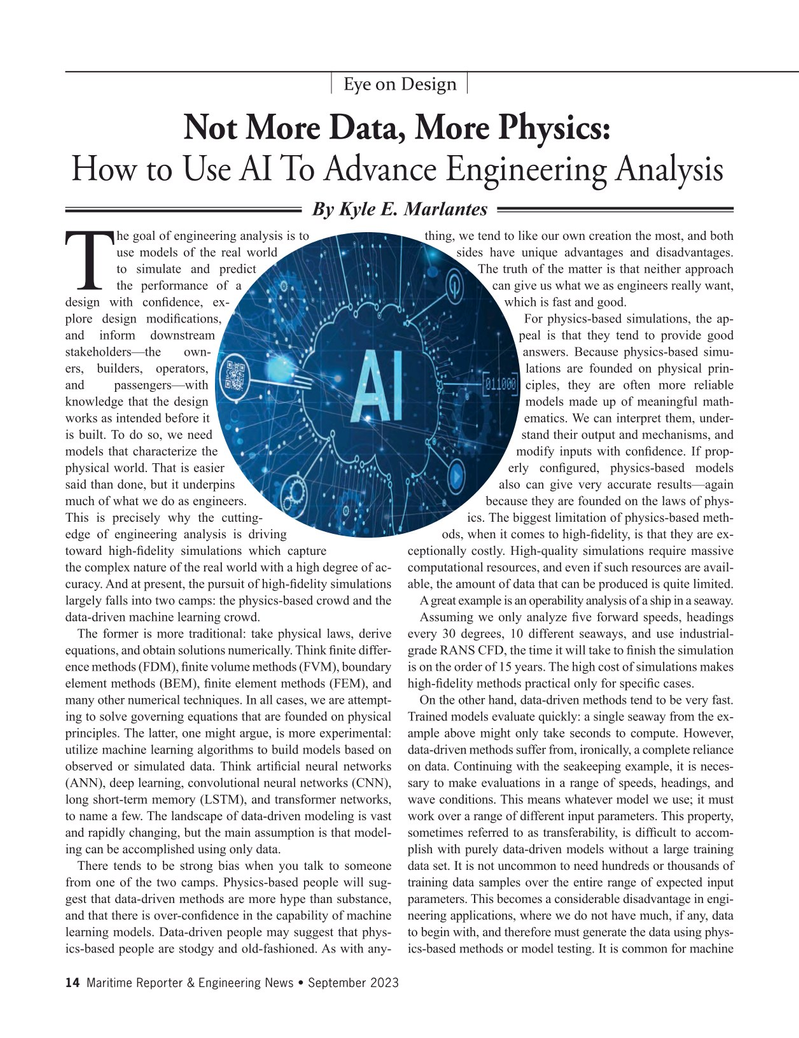
Page 14: of Maritime Reporter Magazine (September 2023)
Marine Design Edition
Read this page in Pdf, Flash or Html5 edition of September 2023 Maritime Reporter Magazine
Eye on Design
Not More Data, More Physics:
How to Use AI To Advance Engineering Analysis
By Kyle E. Marlantes he goal of engineering analysis is to thing, we tend to like our own creation the most, and both use models of the real world sides have unique advantages and disadvantages. to simulate and predict The truth of the matter is that neither approach
Tthe performance of a can give us what we as engineers really want, design with con? dence, ex- which is fast and good.
plore design modi? cations, For physics-based simulations, the ap- and inform downstream peal is that they tend to provide good stakeholders—the own- answers. Because physics-based simu- ers, builders, operators, lations are founded on physical prin- and passengers—with ciples, they are often more reliable knowledge that the design models made up of meaningful math- works as intended before it ematics. We can interpret them, under- is built. To do so, we need stand their output and mechanisms, and models that characterize the modify inputs with con? dence. If prop- physical world. That is easier erly con? gured, physics-based models said than done, but it underpins also can give very accurate results—again much of what we do as engineers. because they are founded on the laws of phys-
This is precisely why the cutting- ics. The biggest limitation of physics-based meth- edge of engineering analysis is driving ods, when it comes to high-? delity, is that they are ex- toward high-? delity simulations which capture ceptionally costly. High-quality simulations require massive the complex nature of the real world with a high degree of ac- computational resources, and even if such resources are avail- curacy. And at present, the pursuit of high-? delity simulations able, the amount of data that can be produced is quite limited. largely falls into two camps: the physics-based crowd and the A great example is an operability analysis of a ship in a seaway. data-driven machine learning crowd. Assuming we only analyze ? ve forward speeds, headings
The former is more traditional: take physical laws, derive every 30 degrees, 10 different seaways, and use industrial- equations, and obtain solutions numerically. Think ? nite differ- grade RANS CFD, the time it will take to ? nish the simulation ence methods (FDM), ? nite volume methods (FVM), boundary is on the order of 15 years. The high cost of simulations makes element methods (BEM), ? nite element methods (FEM), and high-? delity methods practical only for speci? c cases.
many other numerical techniques. In all cases, we are attempt- On the other hand, data-driven methods tend to be very fast. ing to solve governing equations that are founded on physical Trained models evaluate quickly: a single seaway from the ex- principles. The latter, one might argue, is more experimental: ample above might only take seconds to compute. However, utilize machine learning algorithms to build models based on data-driven methods suffer from, ironically, a complete reliance observed or simulated data. Think arti? cial neural networks on data. Continuing with the seakeeping example, it is neces- (ANN), deep learning, convolutional neural networks (CNN), sary to make evaluations in a range of speeds, headings, and long short-term memory (LSTM), and transformer networks, wave conditions. This means whatever model we use; it must to name a few. The landscape of data-driven modeling is vast work over a range of different input parameters. This property, and rapidly changing, but the main assumption is that model- sometimes referred to as transferability, is dif? cult to accom- ing can be accomplished using only data. plish with purely data-driven models without a large training
There tends to be strong bias when you talk to someone data set. It is not uncommon to need hundreds or thousands of from one of the two camps. Physics-based people will sug- training data samples over the entire range of expected input gest that data-driven methods are more hype than substance, parameters. This becomes a considerable disadvantage in engi- and that there is over-con? dence in the capability of machine neering applications, where we do not have much, if any, data learning models. Data-driven people may suggest that phys- to begin with, and therefore must generate the data using phys- ics-based people are stodgy and old-fashioned. As with any- ics-based methods or model testing. It is common for machine 14 Maritime Reporter & Engineering News • September 2023
MR #9 (1-17).indd 14 9/6/2023 4:35:43 PM

 13
13

 15
15
